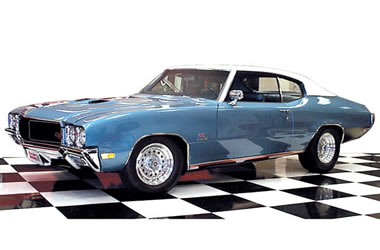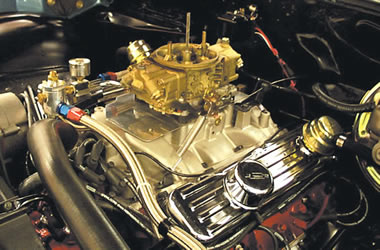Richard Lasseter made hot rod history way back in 1984 when his 1970 Buick Gran Sport Stage 1 automatic beat a Plymouth GTX Hemi four-speed in a shootout sponsored by Car Review magazine (now Muscle Car Review). When the tire smoke cleared, the Stage 1 455 had beat the Hemi with a best run of 12.30 at 110.97 miles-per-hour.
Fast-forward a bunch of years. Richard still owned the GS (affectionately known as Ol’ Blue), and was asked to participate in another shootout. This time, it was a contest between carburetors on the chassis dyno at Holley Performance Products.
The idea behind the carb shootout was simple. Baseline runs would be made with the car in “as-is” condition, followed up with runs using three different carburetors: the 1,000 cfm Holley HP the 455 came with. a Holley HP Series 950 cfm double pumper, and an 870 cfm Street Avenger with vacuum secondaries.
The Holley engineering team conducted the testing and installation chores. The results were averaged to determine the comparison numbers.
In a classic case of “bigger is not always better,” the Stage 1 455 made more power with the 950 HP double pumper than with its original 1,000 cfm HP carburetor. The relatively low-revving Stage 1 doesn’t require any more than 950 cfm to make horsepower.
It is important to point out that the tests were conducted with a full 2.5-inch dual exhaust system. If the GS had open headers or a larger set of pipes, the extra breathing capacity might have made the bigger carburetor a better choice.
Another factor affecting the results was the 10-inch torque converter. The dyno revealed it stalled between 3,400-3,500 rpm under load at full throttle—too loose for the combination. Because a loose converter tends to soak up horsepower and turn it into heat, the converter might have cost us 15 to 20 horsepower at the rear wheels. Another dyno session would tell us for sure. Maybe next time, huh?













This GS’s engine was rebuilt only once by Richard in 1980. He was a physics teacher at the time and I watched him build it at school on a sturdy lab bench. He was a great guy to be around. I was a student in his class. It was a very simple rebuild because the gas of those days had caused a stock piston to crack between the two compression rings on cylinder # 3. He simply rebuilt the 455 after ball-honing the cylinders, replacing the stock cast pistons with Sealed Power stock replacement forgings and replacing the stock cam with a very mid Sig Erson factory “blueprint” cam. It was a true daily driver street car. It was so mild with its stock 3.42 gear. These were the days of “little guy” shootouts. Richard never owned a trailer and he drove the car to school on a daily basis. In this race that was mentioned, the sponsoring magazine requested that he use an out of the box 700 cfm Holley that they provided. As the article about this old 1984 race stated, vapor lock was a problem with the smallish 700 carb. After the GTX Hemi race, he’d replaced that lean factory jetted carb with his usual “swap meet” 850 Holley before driving home and look what happened when he raced the Hemicuda that was looking for revenge from the GTX’s earlier loss! He REALLY blew that Hemicuda away. Just google “1970 Hemi powered Plymouth GTX vs. 1970 Buick GS Stage 1” for a short 7 min. video of that old 1984 match race.
Prior to this carb test. In 1997, We did a full frame off restoration on Richard Lasseter’s GS, that included building current engine combo at our shop Gran Sport Autobody. At the time it made 507 HP on the engine dyno. http://www.gransportautobody.com We were present for the carb testing at the Holley factory. It was an interesting experience.
I saw this car routinely run consistent 11.60’s and 11.70’s at 114 mph with 10-inch wide slicks at the Gainesville Dragway back in the late 1980’s. It’s true that it was always driven in. It was also very quiet with its full 2.5″ exhaust system. No underwood “tricks” and a true street can with all power options.